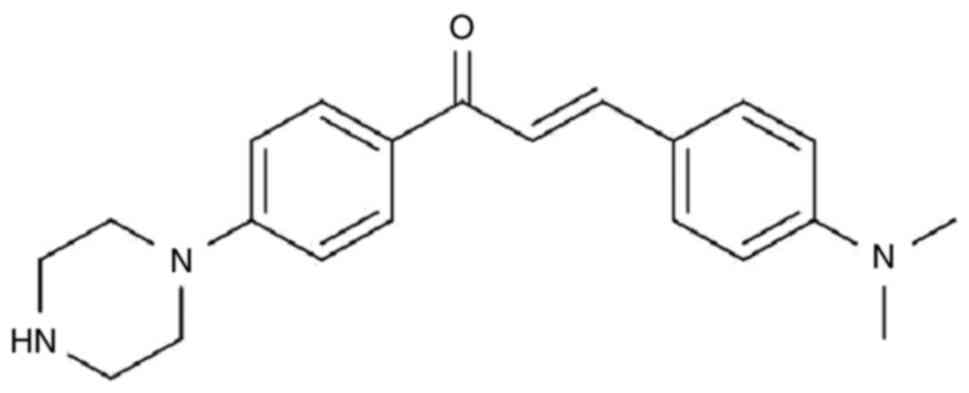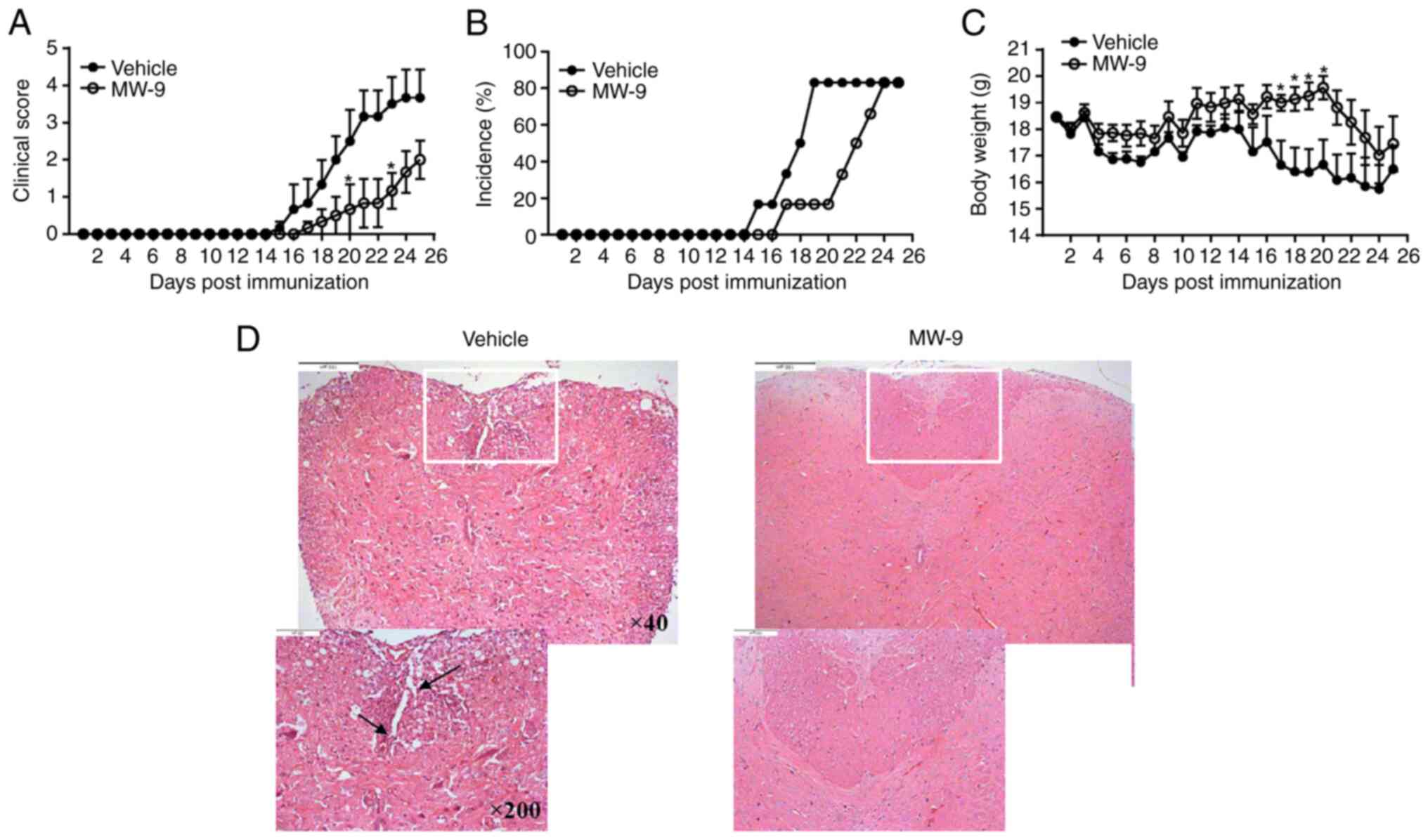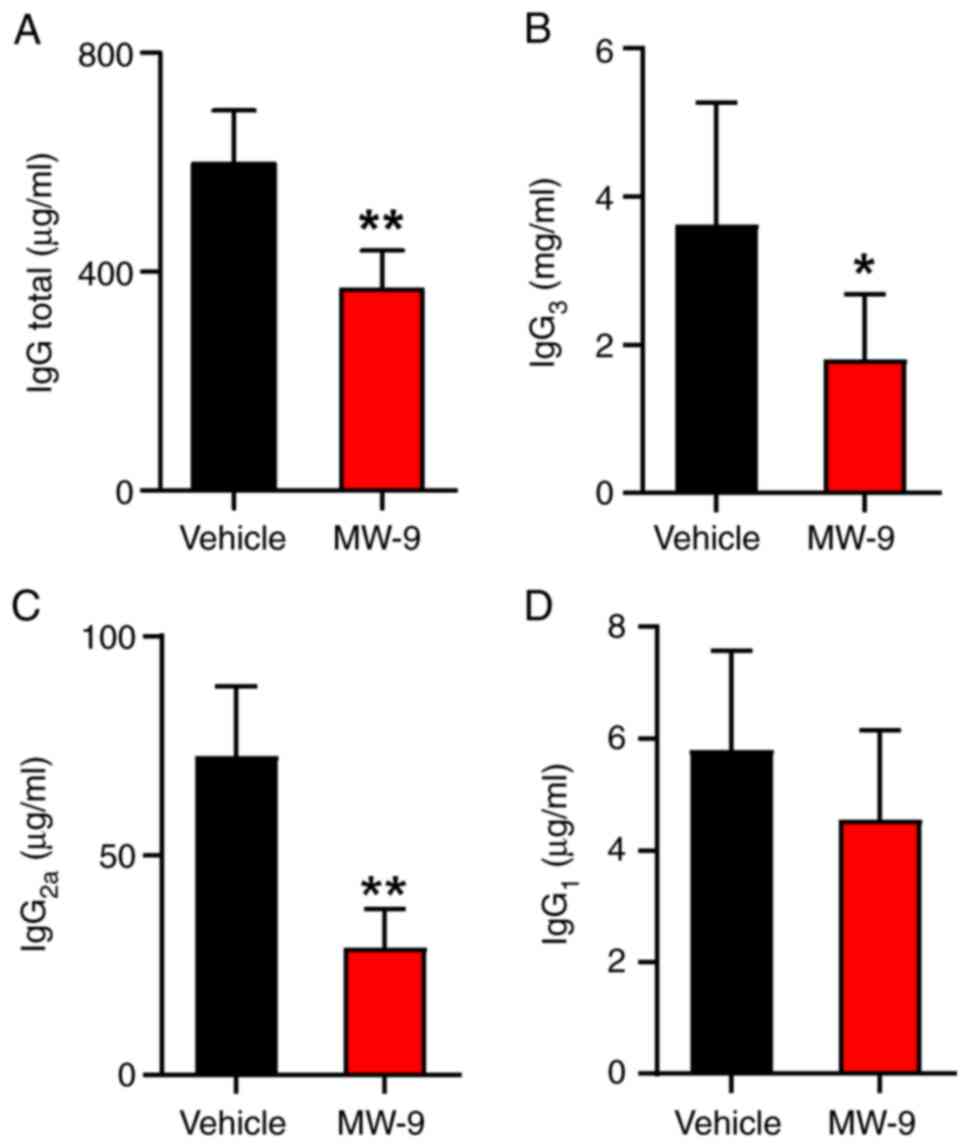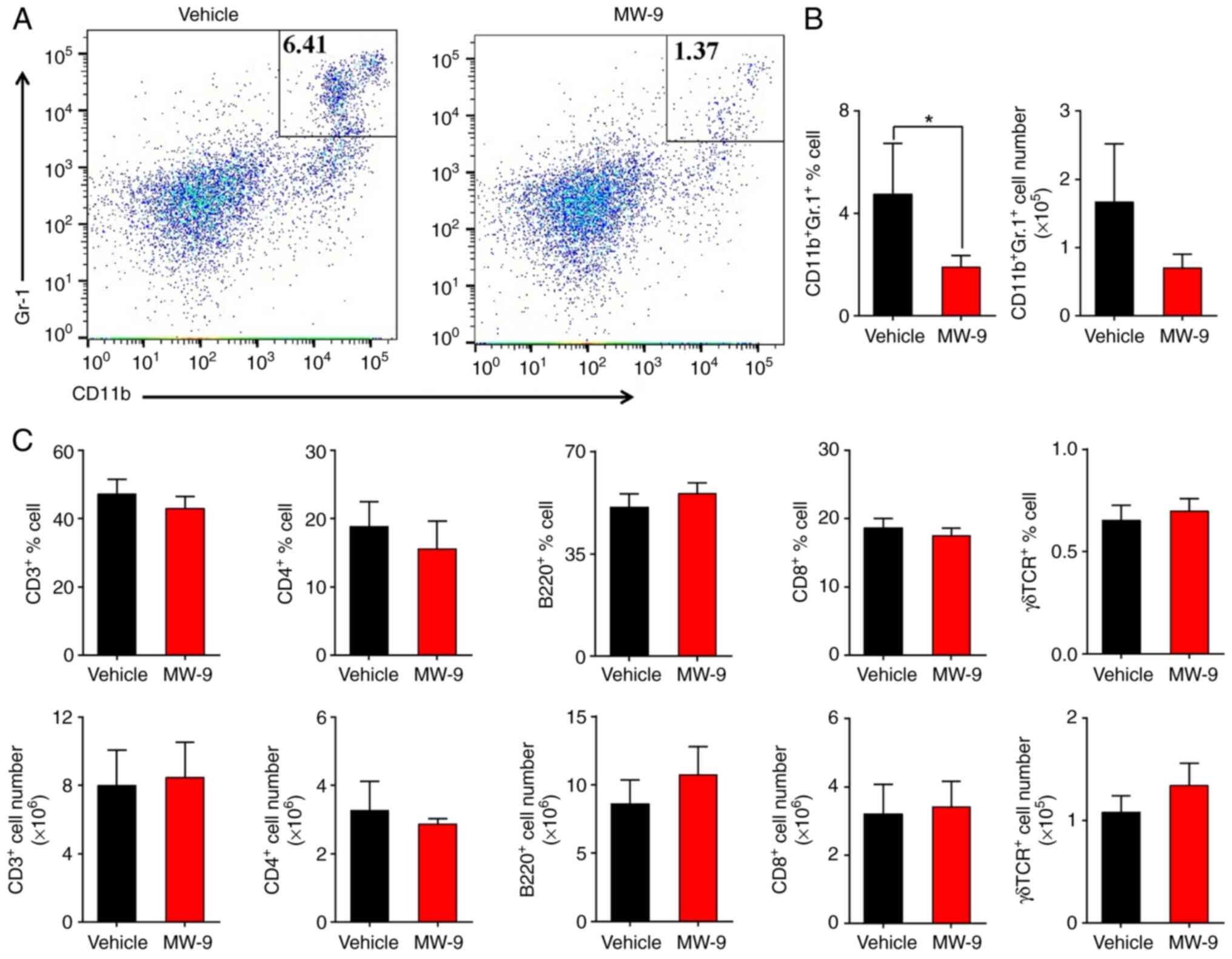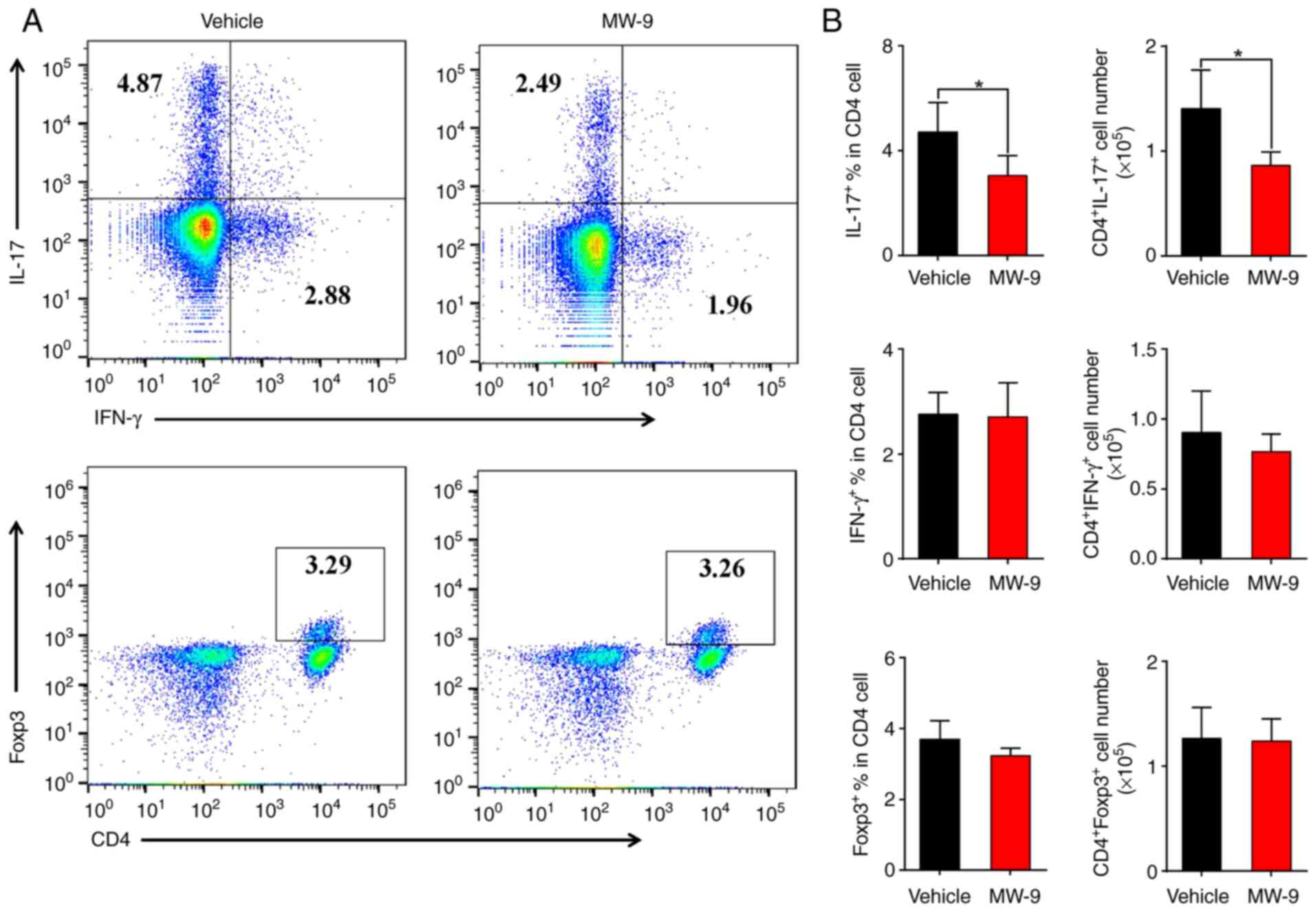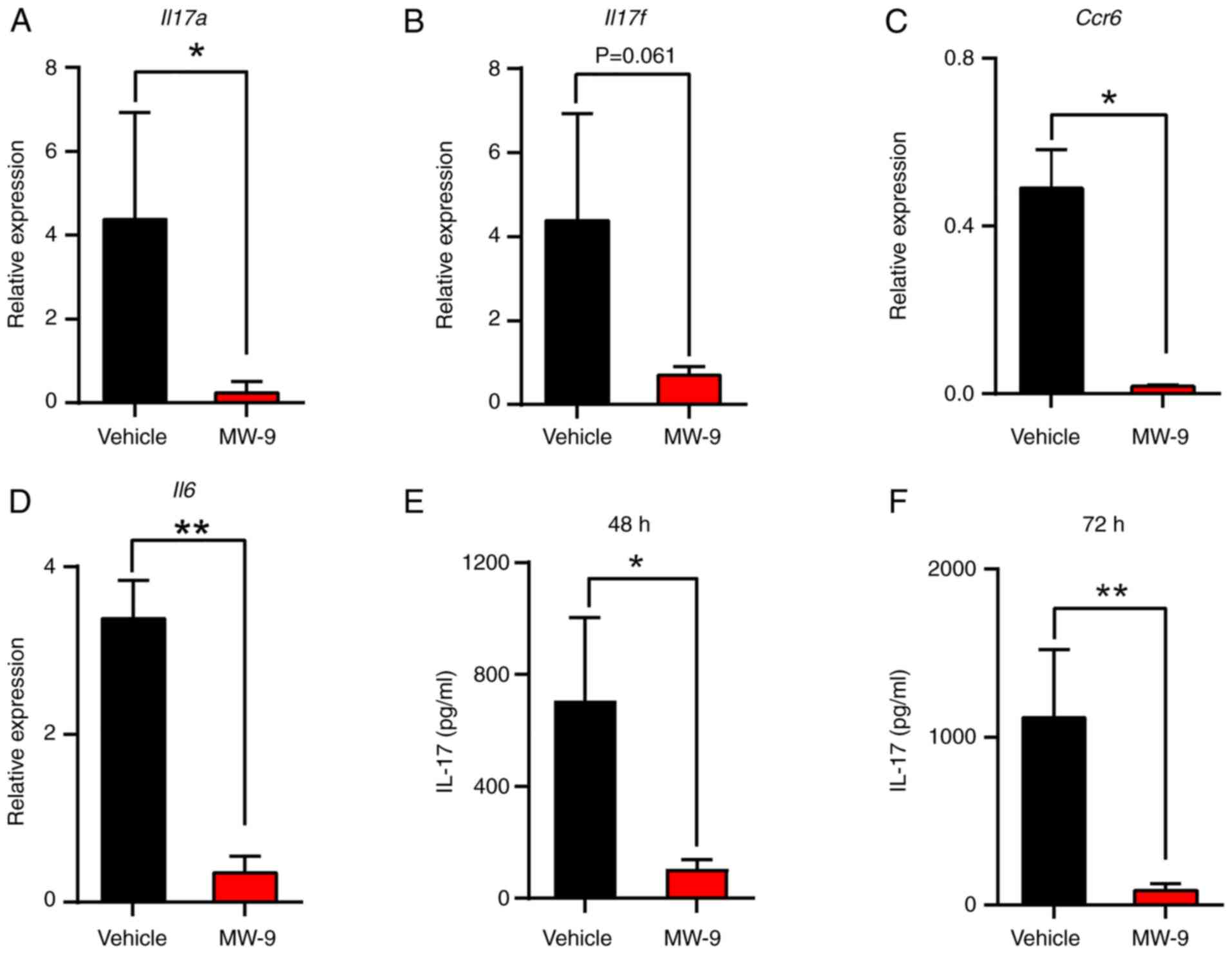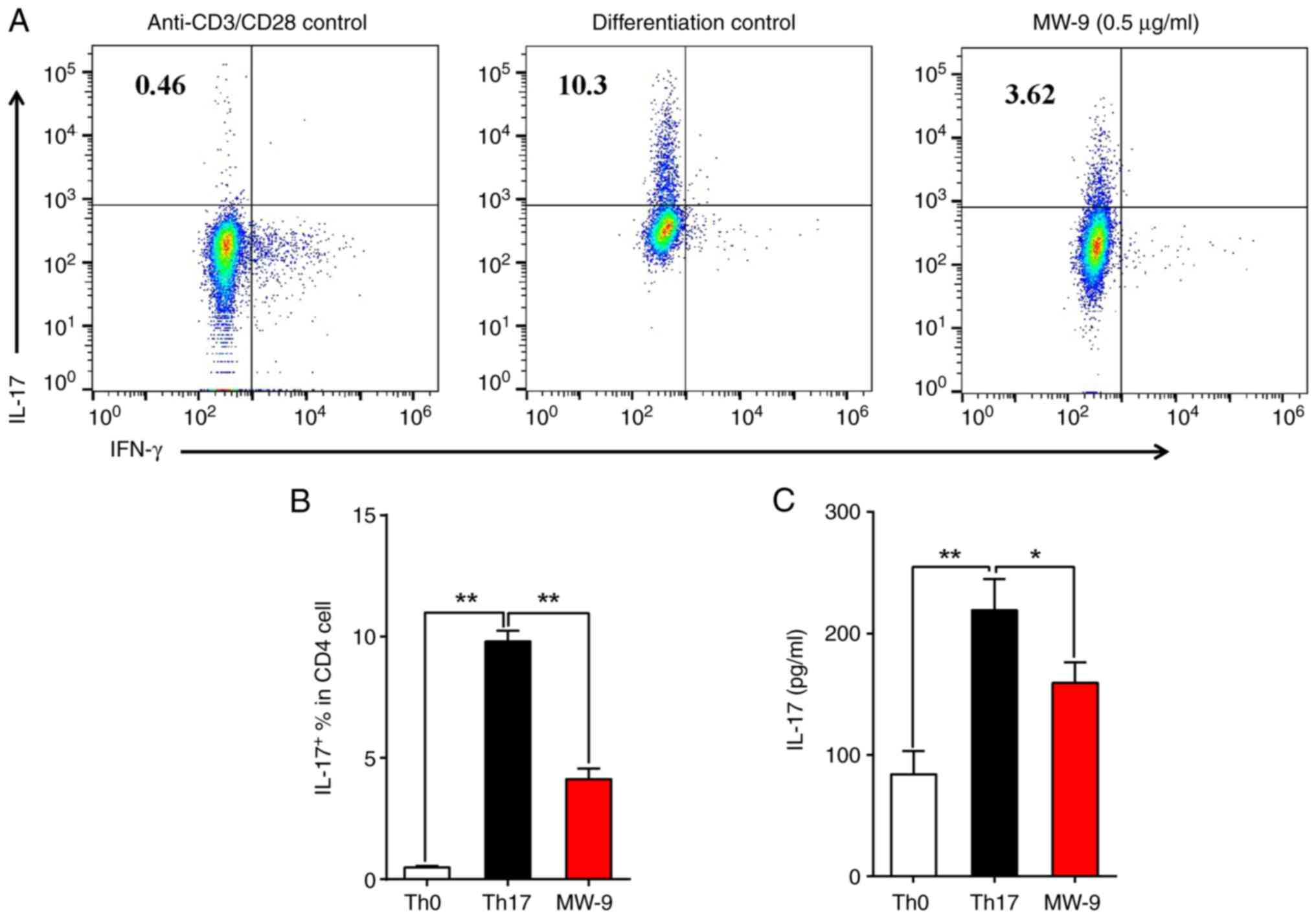MW‑9, a chalcones derivative bearing heterocyclic moieties, attenuates experimental autoimmune encephalomyelitis via suppressing pathogenic TH17 cells
- Authors:
- Published online on: August 11, 2022 https://doi.org/10.3892/mmr.2022.12824
- Article Number: 308
-
Copyright: © Liu et al. This is an open access article distributed under the terms of Creative Commons Attribution License.
Abstract
Introduction
Multiple sclerosis (MS) is a chronic auto-inflammatory disease of the central nervous system (CNS) (1). As a chronic autoimmune disease, MS has a higher incidence in women than men, and it often occurs in young adults. Abnormal inflammatory cells infiltrate into the CNS to initiate lesion formation and finally lead to demyelination of the neuronal axon (2). While, the exact etiological mechanisms remain unclear. Accumulated evidence has revealed that chronic demyelinating disorders of the CNS are primarily induced by self-reactive CD4+ helper-T (TH) cells. While mice lacking TH1 cells can develop this pathology (3), and it has been considered that interferon (IFN)-γ produced by TH1 cells had a key role in the pathogenesis of MS (4). Mice deficient in TH1 cells-associated molecules, such as IFN-γ or IL-12p35 were more susceptible to EAE, while IL-12p40 deficient mice were resistant to disease. With the discoveries that p40 is also a subunit of IL-23 and IL-23 plays a pivotal role in mediating the development of disease. It was revealed that IL23-p19-deficient mice could abrogate the pathogenesis of experimental autoimmune encephalomyelitis (EAE) and downregulate the expression of TH17 cell-associated proteins (5–7). These results highlighted the importance of IL-17-producing TH17 cells in the pathogenesis of EAE.
Chalcones are aromatic ketones that form the central core of a variety of biological compounds. Derivatives of these agents exhibit a broad range of biological activities, in great part due to the presence of their αβ-unsaturated carbonyl system. As such, chalcones could be broadly used in drug research through the use of structural modifications. In previous studies, it was reported that N-heterocyclic-substituted chalcone compounds display a variety of biological activities in tumor cell lines and macrophages (such as A549, HeLa and RAW264.7 cell lines) (8–10). Among these, MW-9 (Fig. 1) appeared to impart a significant inhibitory effect on the generation of nitric oxide and markedly suppressed the production of tumor necrosis factor α in the RAW264.7 murine monocyte/macrophage cell line.
Nonetheless, the therapeutic potential of MW-9 in treating immune-based pathologies remains unknown. In order to explore the biological effects of MW-9 on autoimmune-related pathologies, the present study presented examined the effect of this agent on murine EAE. In the context of EAE, it remains unclear whether MW-9 may affect the levels of IL-17 and TH17 cells. It was expected that information obtained in these studies about potential immunomodulating mechanisms of MW-9 could then be used to assess if the agent could be used for other autoimmune-based pathologies, including MS.
Materials and methods
Experimental animals
A total of 12 C57BL/6 mice (weight 18±2 g; female; 8–10 weeks-old) were obtained from the Shanghai Laboratory Animal Center of the Chinese Academy of Sciences (Shanghai, China). Upon arrival, all mice were housed under specific pathogen-free conditions (12-h light/dark cycles, room temperature of 22±1°C, and a 55±5% relative humidity). All mice had ad libitum access to standard rodent chow and filtered tap water. All mice were allowed to acclimatize for 4 weeks before initiation of any experiment. All experiments were carried out according to the institutional ethical guidelines on animal care, and were approved (approval no. S2019-001) by the Institute Animal Care and Usage Committee of The First Hospital Affiliated Yunnan University of Traditional Chinese Medicine (Kunming, China).
Reagents
MOG35-55 used to induce EAE in the mice was purchased from ProSpec-Tany TechnoGene, Ltd. Freund's complete adjuvant (CFA) containing Mycobacterium tuberculosis (M. tuberculosis) strain H37Rv was obtained from BD Biosciences. Pertussis toxin (PTX) was obtained from List Biological Labs. Mouse allophycocyanin (APC)-conjugated IL-17antibody (cat. no. 506916; cloneTC11-18H10), mouse fluorescein isothiocyanate (FITC)-conjugated interferon (IFN)-γ antibody (cat. no. 505805; clone XMG1.2), mouse PE-Cy7-conjugated CD4 antibody (cat. no. 100528; clone RM4.5), mouse Alexa Fluor@ 488-conjugated Foxp3 (cat. no. 320012; clone MF23) antibody, mouse FITC-conjugated anti-mGr.1 (cat. no 108405; clone RB6-8C5, BD), phycoerythrin (PE)-anti-mCD11b (cat. no. 101255; clone M1/7), mouse FITC-anti-mCD8a (cat. no. 100705; clone 53-6.7), PE-anti-mB220 (cat. no. 103207; clone RA3-682), PE-Cy7-anti-mCD4 (clone GK.1.5), mouse APC-conjugated CD3 (cat. no 100312; clone 145-2C11) were purchased from BioLegend, Inc. ELISA kits for IL-17A (cat. no. 88-7371), IgG (cat. no. 88-50400), IgG1 (cat. no. 88-50410), IgG2a (cat. no. 88-50420) and IgG3 (cat. no. 88-50440) were purchased eBioscience. Reverse transcription kit and SYBR Premix Ex Taq II were purchased from Takara Biotechnology Co., Ltd. RNA extraction kit was purchased from Qiagen, Inc. All primers used were synthesized by Shanghai Bioengineering Co., Ltd.
General procedure for the preparation of MW-9
MW-9 were synthesized in house according to the method previously described (10). Briefly, 20% KOH (10 ml) was added to a solution of 4-dimethyl amino benzaldehyde (0.75 g, 5 mmol) and 4-fluoroacetophenone (0.69 g, 5 mmol) in EtOH (10 ml), and left to react overnight at room temperature. After filtration, the precipitate was washed twice with 50% EtOH-H2O and dried without further purification. The solid was dissolved in dried DMF (15 ml), then Cs2CO3 (3.26 g, 10 mmol) and piperazine (258 mg, 3 mmol) was added and the mixture was stirred for 12 h at 110°C. After completion of the reaction as indicated by thin layer chromatography, the reaction was quenched by the addition of DCM (30 ml) and was washed with water (3×20 ml). The organic layer was dried using anhydrous sodium sulfate, concentrated in vacuo and purified by column chromatography to afford product as yellow solid.
Induction of EAE
MOG35-55-induced EAE in C57BL/6 mice was established as previously described (11–13). In brief, the mice were immunized on day 0 with an intracutaneous injection of 150 mg of MOG35-55 emulsified in CFA-bearing M. tuberculosis strain H37Rv. Injection volume was set at 150 µl. Thereafter, each mouse received an additional 300 ng of PTX by intraperitoneal injection in 100 ml of phosphate-buffered saline (PBS) on day 0 and again on day 2 post-immunization. Clinical assessment of EAE was performed daily and mice were scored according to the following criteria: 0, no overt signs of disease; 1, limp tail or hind limb weakness but not both; 2, limp tail and hind limb weakness; 3, partial hind limb paralysis; 4, complete hind limb paralysis; 5, moribund state or dead.
Treatment protocols
MW-9 was dissolved in PBS containing 0.5% sodium CM-cellulose (Qiangshun Inc.). The MW-9 solution was prepared in a manner that the mice could receive a per os dose of 40 mg/kg in each treatment (volume=200 µl). Control mice received an equal volume of PBS containing 0.5% CM-cellulose. MW-9 and vehicle were respectively administered from day 1 post-immunization and then daily for 25 days. This particular dose of MW-9 was chosen based upon pilot study results assessing antiarthritic potential (data not shown). On the 25th day of the experiment, all mice were euthanized using 30% carbon dioxide of the cage volume per min, then used the following methods to confirm the death of animals, including lack of a heartbeat, lack of respiration, lack of corneal reflex and presence of rigor mortis. Samples (spinal columns, spleen, blood for serum) were collected for analyses as described below.
Hematoxylin-Eosin (H&E) staining
At necropsy, the spinal cord of each mouse was collected. A portion of this tissue was then fixed with 4% formalin at room temperature for 3 days. Thereafter, each underwent dehydration in alcohols and embedment in paraffin, then these were sectioned (to 5 µm) and stained with H&E at room temperature for 1 h. Each slide was evaluated using a light microscope to detect any inflammatory cell aggregation in the myelin and the extent of any demyelination.
Production of cytokines and specific antibodies
At necropsy, lymph nodes of all the MOG35-55-induced mice were collected and lymphocytes from each group were then isolated using standard protocols. After counting, the isolated cells were placed in 24-well plates (2×106 cells/well) and then stimulated by addition of MOG35-55 (to yield a final dose of 10 µg MOG35-55/ml in each well); and parallel wells received only vehicle as ‘stimulant’. Plates were then cultured at 37°C. The supernatants from all wells were harvested after 48 h in order to assess IL-17 produced by the cells. Each sample was evaluated using specific murine ELISA IL-17 assays (Thermo Fisher Scientific, Inc.) following the manufacturer's protocol. The sensitivity level of the kits was 4 pg/ml. The concentration of IL-17A and anti-mouse IgG, IgG1, IgG2a and IgG3 in serum were isolated from the mice at the peak of the disease process.
Reverse transcription-quantitative (RT-q) PCR assay
Total RNA from remaining spinal cord tissue isolated from each mouse was isolated using RNA simple Total RNA kit (Tiangen Biotech Co., Ltd.). After confirming the purity (wavelength 260/280 nm) and concentration (wavelength 260 nm) of each isolate using a NANODrop2000 (Thermo Fisher Scientific, Inc.), 1 µg of total RNA was used to synthesize cDNA using a PrimeScript RT Master Mix Perfect Real-Time kit (Takara Biotechnology Co., Ltd.). The transcriptional conditions were 37°C for 15 min and 85°C for 5 sec, and then followed by maintenance at 4°C (14,15). Synthesized cDNA was used in RT-qPCR experiments using SYBR Premix Ex Taq II kits (Takara Biotechnology Co., Ltd.). Each 20 µl of reaction contained 10 µl of SYBR Green Mix, 8.4 µl of nuclease-free H2O, 1 µl of cDNA, 0.3 µl of forward primer and 0.3 µl of reverse primer. The thermocycling conditions for qPCR were as follows: Initial denaturation at 95°C for 30 sec, followed by 40 cycles of 95°C for 5 sec and 62°C for 20 sec. From this, the relative mRNA expression of several TH17 cell-related genes (Il17a, Il17f, Il6 and Ccr6) were measured. The primer sequences were synthesized by Tsingke Biotechnology Co., Ltd. All samples were assayed on a Stratagene MX3000P Real-Time PCR system (Agilent Technologies, Inc.). Relative quantitation of mRNA expression was calculated as the fold-increase in expression by using the 2−ΔΔCq method and the β-actin housekeeping gene (16). The primer sequences of specific genes were as follows: Il17a forward, 5′-TTTAACTCCCTTGGCGCAAAA-3′ and reverse, 5′-CTTTCCCTCCGCATTGACAC-3′; Il17f forward, 5′-CTGTTGATGTTGGGACTTGCC-3′ and reverse, 5′-TCACAGTGTTATCCTCCAGG-3′; Ccr6 forward, 5′-CCTGGGCAACATTATGGTGGT-3′ and reverse, 5′-CAGAACGGTAGGGTGAGGACA-3′; Il6 forward, 5′-CGGAGAGGAGACTTCACAGAG-3′ and reverse, 5′-CATTTCCACGATTTCCCAGA-3′; and β-actin forward, 5′-GGCTGTATTCCCCTCCATCG-3′ and reverse, 5′-CCAGTTGGTAACAATGCCATGT-3′.
Flow cytometry
To assess expression of various lymphocyte types in the hosts with EAE, lymphocytes were harvested (centrifugation at 300 g × at 4°C for 5 min) at necropsy from lymph nodes of the MOG35-55-treated mice using standard protocols (15). Aliquots of the cells (106 total) were then blocked by incubation in 100 ml of PBS containing 1 µg/ml of rat-anti-mouse CD16/CD32 (clone 2.4G2; BioLegend, Inc.) for 10 min at 4°C. Thereafter, dedicated sets of cells from each mouse were labeled by incubation for 15 min (at 4°C) in a solution of staining buffer containing one of the following rat anti-mouse monoclonal antibodies (1:100 dilution; all from BioLegend, Inc.): FITC-conjugated anti-mGr.1 (clone RB6-8C5), phycoerythrin (PE)-anti-mCD11b (clone M1/7), FITC-anti-mCD8a (clone 53–6.7), PE-anti-mB220 (clone RA3-682), or PE-Cy7-anti-mCD4 (cloneGK.1.5), APC-conjugated CD3 (clone 145-2C11).
Intracellular cytokine staining for IFN-γ and IL-17A was performed using Foxp3 fixation-permeabilization reagent, following a protocol from eBioscience; Thermo Fisher Scientific, Inc. In brief, aliquots of the isolated lymphocytes (2×106 total) were plated into 24-well dishes and then stimulated for 4 h with 50 ng/ml phorbol myristate acetate and 750 ng ionomycin/ml (both from Sigma-Aldrich; Merck KGaA) in the presence of Brefeldin A (BioLegend, Inc.). The cells were then collected, blocked with rat-anti-mouse CD16/CD32 (as aforementioned), stained with PE-Cy7-conjugated rat anti-mCD4 (as aforementioned), then fixed by fixation/permeabilization buffer (eBioscience; cat. no. 005123-43) for 30 min at 4°C permeabilized, and again stained for 45 min at 4°C with APC-conjugated rat anti-mIL-17A (clone TC11-18H10.1) or FITC-rat anti-mIFN-γ (clone XMG1.2) (1:100 dilution; both from BioLegend, Inc.). The aforementioned stimulation was not required for the staining of intracellular Foxp3 that was also performed using Alexa Fluor@ 488-conjugated rat anti-mFoxp3 (clone 150 D; BioLegend, Inc.).
In all of the above cases, samples were evaluated on a FACs Canto II flow cytometer (BD Biosciences) and analyzed using FlowJo software v10.6.2 (FlowJo LLC) (17,18). A minimum of 10,000 events/sample was acquired.
TH17 differentiation of CD4+ cells in vitro
The methods used to evaluate TH17 cell polarization here are those previously described in Li et al (11) and Hou et al (19). In brief, murine splenocytes from untreated ‘naïve’ mice (no EAE) were prepared and incubated (1:4 dilution) with Biotin-Antibody Cocktail (Miltenyi Biotec GmbH) for 10 min at 4°C to deplete CD11b+, CD8α+ and CD19+ cells. Then, these cells were exposed to Anti-biotin Microbeads (Miltenyi Biotec GmbH) for 10 min at 4°C, and the enriched CD4+ T cells were isolated by MACS separator. Purity of the isolated cells was evaluated by staining of representative aliquots with PE-Cy7-rat anti-mCD4 as aforementioned.
For the assay, the ‘naïve’ CD4 T-cells from each mouse were plated into 24-well plates (4×105/well) whose wells had been pre-coated with rat anti-mCD3 (clone 154-2C11, 5 µg/ml: BioLegend, Inc.), anti-mCD28 (clone 37.51, 2.5 µg/ml: BioLegend, Inc.), and a set of four polarizing cytokines. The latter included recombinant mouse IL-6 (10 ng/ml), recombinant human TGF-β1 (2 ng/ml), anti-mouse IL-4 (10 µg/ml), and anti-mouse IFN-γ (10 µg/ml) (all from BioLegend, Inc.). After 72 h of incubation at 37°C, the supernatants from each well were collected to permit quantification of IL-17A levels by ELISA.
To detect IL-17A expression on cells that were induced to differentiate into TH17 cells, other wells containing isolated ‘naïve’ CD4 T-cells from each mouse plated into 24-well plates (106 total) were stimulated with phorbol myristate acetate and ionomycin in the presence of Brefeldin A for 4 h, and then fixed (as aforementioned) for 30 min at 4°C, permeabilized and stained for 45 min at 4°C with fluorochrome-conjugated anti-mIL-17A (1:100 dilution). These cells then underwent flow analyses as aforementioned.
Statistical analysis
All data are expressed as the mean ± SEM. Two independent sample t-test was used to determine whether differences between two given groups were significant. One-way analysis of variance (one-way ANOVA) and Bonferroni test were used for comparison among multiple groups and pairwise comparison from multiple groups, respectively. P<0.05 was considered to indicate a statistically significant difference. All data were analyzed using SPSS 20.0 software (IBM Corp.).
Results
MW-9 alleviates development of EAE in MOG35-55-immunized C57BL/6 mice
To assess therapeutic potential of MW-9, mice were immunized with MOG35-55 peptide emulsified with CFA on day 0 and then gavaged with MW-9 (40 mg/kg) or vehicle on the day of immunization to the end of experiment. Severity of EAE due to the presence or absence of MW-9 treatment was then evaluated. As revealed in Fig. 2A, clinical scores gradually increased as EAE progressed. Scores in the MW-9 treatment group were significantly reduced as compared with those in the vehicle group. In addition, by day 19, 80% of the control mice developed severe EAE. In comparison, <20% of mice showed mild signs of disease in the MW-9-treated group (Fig. 2B). MW-9 treatment also markedly prevented a loss of body weight due to EAE (Fig. 2C). Although MW-9 exhibited delayed and ameliorated disease, the incidence in MW-9 treated group was increased after day 24 post immunization, thus the difference between these two groups decreased after day 24.
To assess effects of MW-9 on infiltration of immune cells and demyelination of the spinal cord, histologic analysis was performed after the treatments ended. The data indicated that by day 25, mice in the vehicle group had typical pathological changes, including severe infiltration of inflammatory cells and demyelination of their spinal cords. By contrast, in mice treated with MW-9, the extent of both infiltration and demyelination was markedly reduced (Fig. 2D).
MW-9 blocks anti-MOG35-55 IgG antibody production
To monitor effects of MW-9 on antibody responses to MOG35-55 peptide, serum levels of anti-MOG35-55 peptide IgG, IgG1, IgG2a and IgG3 were determined by ELISA. As revealed in Fig. 3, serum levels of total IgG in the MW-9 treatment group were significantly decreased on day 25 compared with the control EAE mice (Fig. 3A). Furthermore, compared with the control group, MW-9 treatment also reduced the production of anti-MOG35-55 IgG3 (Fig. 3B) and IgG2a (Fig. 3C). However, MW-9 appeared to impart no effect on anti-MOG35-55 IgG1 levels (Fig. 3D).
MW-9 inhibits accumulation of neutrophils
To examine the effects of MW-9 on the types of leukocytes in the spleens of mice with EAE, flow cytometric analysis was performed. On day 25, the proportion and cell number of CD11b+Gr-1+ neutrophils in the MW-9 treated mice was decreased compared with the vehicle group (Fig. 4A and B). The data indicated that MW-9 did not influence the expression of CD3+, CD8+, or CD4+ T cells, and no effects on γδ TCR+ T or B220+ B cells were observed (Fig. 4C).
MW-9 markedly suppresses TH17 cell responses in EAE
Since TH17 cells and IL-17 contribute to the pathogenesis of autoimmune disorders such as EAE (20), it was further determined whether MW-9 could influence these parameters during EAE through evaluating the expression of intracellular cytokines in CD4+ T cells via flow cytometry. As revealed in Fig. 5, compared with the vehicle control mice, MW-9 treatment significantly suppressed IL-17A expression in CD4+ T cells (Fig. 5A and B). However, MW-9 treatment did not affect the expression of IFN-γ+ and Foxp3+ CD4+ T cells in the hosts (Fig. 5A and B).
MW-9 suppresses production of IL-17 and expression of TH17 cell-related genes
There is evidence that TH17 cells play a critical pathogenic role in EAE (21) and the present data indicated that MW-9 markedly inhibited TH17 cell responses during EAE. To assess the expression of TH17 cell-related cytokines/proteins, spinal cords were isolated on day 25 and analyzed by RT-qPCR. The results demonstrated that MW-9 treatment significantly downregulated Il17a, Il17f, Ccr6 and Il6 mRNA expression (Fig. 6A-D). The data also indicated that IL-17A produced by cells from the MW-9-treated mice was lower than that from the vehicle control. These findings were consistent with the gene expression data (Fig. 6E and F).
MW-9 suppresses TH17 cell differentiation in vitro
To ascertain whether MW-9 could affect TH17 cell differentiation, CD4+ T cells were isolated from the spleens of naive mice and then induced to differentiate into TH17 cells under polarizing conditions for 3 days in the presence/absence of MW-9. The results indicated that MW-9 treatment significantly suppressed TH17 cell differentiation (Fig. 7A and B). In addition, IL-17A production was also reduced in MW-9-treated cells (Fig. 7C).
Discussion
MS is an autoimmune disease affecting both adults and children. It is driven by TH cells and white blood cells that result in inflammatory attacks on the brain and spinal cord, and ultimately the degradation of the protective myelin sheath on nerve fibers. There are numerous different kinds of TH cells, but which ones are the main pathogenic forms in MS remain unknown. EAE, a classical animal model for MS, is characterized by abnormal inflammatory cells that infiltrate into the CNS, initiating lesion formation and demyelination of neuronal axons (2). In the present study, the therapeutic potential of the chalcone MW-9 on autoimmune disorders such as MS was evaluated in vivo in murine hosts with EAE. Notably, oral administration of MW-9 for a period of 19 days ameliorated the severity of the induced EAE. This effect was accompanied by significant reduction in leukocyte infiltration and demyelination of the spinal columns. It was reported that T-cells played a pivotal role in the pathogenesis of numerous autoimmune diseases and chronic inflammatory disorders, including EAE (22). CD4+ TH cells are important mediators in immune responses, as they regulate other cellular components of the immune system. Upon activation by antigens or cellular signals, naïve CD4 cells can differentiate into various subtypes, including TH1, TH2, TH17 and Treg, which in turn produce their own arrays of cytokines and perform specific immune regulatory functions (22). Inflammatory TH17 cells have been identified as a distinct TH cell lineage that can mediate tissue specificity during autoimmunity (23,24), including pathologies such as EAE (25).
The therapeutic potentials of MW-9 on treating immune-based pathologies remains unknown. In order to explore the biological effects of MW-9 on autoimmune-related pathologies, the effect of this agent on murine EAE was examined in the present study. In the context of EAE, it remains unclear what effects MW-9 may have on IL-17 levels, TH17 cells, and on key cytokines in hosts treated with this chalcone. The results showed that MW-9 treatment (under the specified paradigm) significantly reduced the production of TH17-related cytokine IL-17A in the MOG35-55-induced immune responses in the mice. Intracellular cytokine staining revealed that MW-9 suppressed IL-17A expression in CD4+ T-cells without affecting the proportions of IFN-γ+ and Foxp3+ CD4+ T-cells. This suggested that MW-9 could selectively inhibit TH17-mediated tissue inflammatory responses, but may exert no influence on TH1 and Treg cell levels/activities, at least in the context of an ongoing EAE response.
It has been reported that TH17 differentiation is initiated by TGF-b and IL-6, and is further reinforced by IL-23 (26). TH17 cells produce IL-17A, IL-17F and IL-22, that regulate inflammatory responses (21,27), but the present study did not directly examine the effect of MW-9 on these cytokines. Thus, the changes in TH17 levels/activities observed could be a result of either changes in T-cell responsivity to one or more of the aforenoted activating cytokines or in the host ability to form these agents. The results from the differentiation assay using naïve T-cells revealed that MW-9 treatment markedly inhibited TH17 differentiation. Thus, it holds true that TH17 responses are altered in the EAE mice. Ongoing studies to re-analyze the mice sera for levels of TGF-b, IL-6, IL-23 and IL-22 will help to clarify the underlying mechanisms in an improved way.
Analogous to STAT4 and STAT1 in Th1 and STAT6 in Th2 cell, STAT3 was found to selectively mediate TH17 differentiation (28). Overexpression of a hyperactive STAT3 enhanced Th17 differentiation, whereas STAT3 deficiency impaired Th17 differentiation in vitro. Th17-specific transcription factor RORγt was recently shown to be selectively expressed in Th17 cells and regulated by STAT3 (29). Overexpression of RORγt promotes Th17 differentiation when Th1 and Th2 development is inhibited. Conversely, RORγτ deficiency results in profound Th17 deficiency. In vivo, oral administration of MW-9 significantly reduced the expression of IL-17 producing T cells compared with the vehicle group. Consistent with in vivo results, MW-9 also impaired Th17 cell differentiation and IL-17-production in vitro, confirming that the inhibitory effect of MW-9 on Th17 cell differentiation is responsible for the effect of MW-9 on EAE. In the present study, oral administration of MW-9 significantly decreased the IL-17 production in MOG35-55 induced-specific immune response and in serum of mice. Importantly, MW-9 treatment significantly inhibited IL-17 expression in CD4+ T-cells in EAE model, accompanied by the reduced production of MOG35-55 peptide-specific antibodies (IgG, IgG2a and IgG3), which may contribute to the protective effect of MW-9 on EAE.
Overall, the data demonstrated that oral administration of MW-9 could attenuate EAE in mice by inhibiting pathogenic TH17 cells. Importantly, MW-9 treatment significantly inhibited IL-17 expression in CD4+ T-cells and TH17 cell differentiation in vitro. Both of these changes induced by MW-9 may help to explain why under the current experimental paradigm, MW-9 may provide a protective effect against EAE.
Acknowledgements
Not applicable.
Funding
The present study was supported by the Natural Science Foundation of China (grant nos. 81960745 and 81960868), the Yunnan Provincial Science and Technology Department-Applied Basic Research Joint Special Fund of Yunnan University of Traditional Chinese Medicine [grant no. 2018FF001(−009)] and the Yunnan Applicative and Basic Research Program (grant no. 2018FY001-001).
Availability of data and materials
The datasets generated and/or analyzed during the current study are available from the corresponding author on reasonable request.
Authors' contributions
CW and ZM designed the present study; BL, SY and NY performed biological research, analyzed data and wrote the manuscript; and QG, YQ, XL, HY, ZW and NZ participated in data analysis. CW reviewed and edited the manuscript. CW, BL and SY confirm the authenticity of all the raw data. All authors have read and approved the final version of the manuscript.
Ethics approval and consent to participate
All experiments were carried out according to the institutional ethical guidelines on animal care and were approved (approval no. S2019-001) by the Institute Animal Care and Usage Committee of the No. 1 Hospital Affiliated Yunnan University of Traditional Chinese Medicine (Kunming, China).
Patient consent for publication
Not applicable.
Competing interests
The authors declare that they have no competing interests.
References
|
Liu Q, Gao Q, Zhang Y, Li Z and Mei X: MicroRNA-590 promotes pathogenic Th17 cell differentiation through targeting Tob1 and is associated with multiple sclerosis. Biochem Biophys Res Commun. 493:901–908. 2017. View Article : Google Scholar : PubMed/NCBI | |
|
Handel AE, Lincoln MR and Ramagopalan SV: Of mice and men: Experimental autoimmune encephalitis and multiple sclerosis. Eur J Clin Invest. 41:1254–1258. 2011. View Article : Google Scholar : PubMed/NCBI | |
|
Gran B, Zhang GX, Yu S, Li J, Chen XH, Ventura ES, Kamoun M and Rostami A: IL-12p35-deficient mice are susceptible to experimental autoimmune encephalomyelitis: Evidence for redundancy in the IL-12 system in the induction of central nervous system autoimmune demyelination. J Immunol. 169:7104–7110. 2002. View Article : Google Scholar : PubMed/NCBI | |
|
El-behi M, Rostami A and Ciric B: Current views on the roles of Th1 and Th17 cells in experimental autoimmune encephalomyelitis. J Neuroimmune Pharmacol. 5:189–197. 2010. View Article : Google Scholar : PubMed/NCBI | |
|
Cua DJ, Sherlock J, Chen Y, Murphy CA, Joyce B, Seymour B, Lucian L, To W, Kwan S, Churakova T, et al: Interleukin-23 rather than interleukin-12 is the critical cytokine for autoimmune inflammation of the brain. Nature. 421:744–748. 2003. View Article : Google Scholar : PubMed/NCBI | |
|
Langrish CL, McKenzie BS, Wilson NJ, de Waal Malefyt R, Kastelein RA and Cua DJ: IL-12 and IL-23: Master regulators of innate and adaptive immunity. Immunol Rev. 202:96–105. 2004. View Article : Google Scholar : PubMed/NCBI | |
|
Komiyama Y, Nakae S, Matsuki T, Nambu A, Ishigame H, Kakuta S, Sudo K and Iwakura Y: IL-17 plays an important role in the development of experimental autoimmune encephalomyelitis. J Immunol. 177:566–573. 2006. View Article : Google Scholar : PubMed/NCBI | |
|
Lin Y, Hu C, Zheng X, Wang X and Mao Z: Synthesis and anti-tumor activities of novel 4′-(N-substitued-1-piperazinyl) chalcone derivatives. Chin J Org Chem. 37:237–241. 2017. View Article : Google Scholar | |
|
Hui G, Xi Z, Ping Z, Si W, Chunping W, Gaoxionga R and Zewei M: Synthesis and biological evaluation of novel substituted chalcone-piperazine derivatives. Chin J Org Chem. 38:684–691. 2018. View Article : Google Scholar | |
|
Mao Z, Zheng X, Lin Y, Qi Y, Hu C, Wan C and Rao G: Concise synthesis and biological evaluation of chalcone derivatives bearing N-heterocyclic moieties. Heterocycles. 92:1102–1110. 2016. View Article : Google Scholar | |
|
Li X, Li TT, Zhang XH, Hou LF, Yang XQ, Zhu FH, Tang W and Zuo JP: Artemisinin analogue SM934 ameliorates murine experimental autoimmune encephalomyelitis through enhancing the expansion and functions of regulatory T cell. PLoS One. 8:e741082013. View Article : Google Scholar : PubMed/NCBI | |
|
Contarini G, Giusti P and Skaper SD: Active induction of experimental autoimmune encephalomyelitis in C57BL/6 mice. Neurotrophic Factors. Springer; pp. 353–360. 2018, View Article : Google Scholar | |
|
Hou L, Rao DA, Yuki K, Cooley J, Henderson LA, Jonsson AH, Kaiserman D, Gorman MP, Nigrovic PA, Bird PI, et al: SerpinB1 controls encephalitogenic T helper cells in neuroinflammation. Proc Natl Acad Sci USA. 116:20635–20643. 2019. View Article : Google Scholar : PubMed/NCBI | |
|
Rho TW, Lee SY, Han SY, Kim JH, Lee KH, Kim DS, Kwak HB and Kim YK: Glycyrrhizae radix inhibits osteoclast differentiation by inhibiting c-Fos-dependent NFATc1 expression. Am J Chin Med. 45:283–298. 2017. View Article : Google Scholar : PubMed/NCBI | |
|
Xu S, Zuo A, Guo Z and Wan C: Ethyl caffeate ameliorates collagen-induced arthritis by suppressing TH1 immune response. J Immunol Res. 2017. 74167922017.PubMed/NCBI | |
|
Livak KJ and Schmittgen TD: Analysis of relative gene expression data using real-time quantitative PCR and the 2(−Delta Delta C(T)) method. Methods. 25:402–408. 2001. View Article : Google Scholar : PubMed/NCBI | |
|
Cao YJ, Xu Y, Liu B, Zheng X, Wu J, Zhang Y, Li XS, Qi Y, Sun YM, Wen WB, et al: Dioscin, a steroidal saponin isolated from dioscorea nipponica, attenuates collagen-induced arthritis by inhibiting Th17 cell response. Am J Chin Med. 47:423–437. 2019. View Article : Google Scholar : PubMed/NCBI | |
|
Hou LF, He SJ, Li X, Yang Y, He PL, Zhou Y, Zhu FH, Yang YF, Li Y, Tang W and Zuo JP: Oral administration of artemisinin analog SM934 ameliorates lupus syndromes in MRL/lpr mice by inhibiting Th1 and Th17 cell responses. Arthritis Rheum. 63:2445–2455. 2011. View Article : Google Scholar : PubMed/NCBI | |
|
Hou L, Cooley J, Swanson R, Ong PC, Pike RN, Bogyo M, Olson ST and Remold-O'Donnell E: The protease cathepsin L regulates Th17 cell differentiation. J Autoimmun. 65:56–63. 2015. View Article : Google Scholar : PubMed/NCBI | |
|
Langrish CL, Chen Y, Blumenschein WM, Mattson J, Basham B, Sedgwick JD, McClanahan T, Kastelein RA and Cua DJ: IL-23 drives a pathogenic T cell population that induces autoimmune inflammation. J Exp Med. 201:233–240. 2005. View Article : Google Scholar : PubMed/NCBI | |
|
Chung Y, Yang X, Chang SH, Ma L, Tian Q and Dong C: Expression and regulation of IL-22 in the IL-17-producing CD4+ T lymphocytes. Cell Res. 16:902–907. 2006. View Article : Google Scholar : PubMed/NCBI | |
|
Brzustewicz E and Bryl E: The role of cytokines in the pathogenesis of rheumatoid arthritis-practical and potential application of cytokines as biomarkers and targets of personalized therapy. Cytokine. 76:527–536. 2015. View Article : Google Scholar : PubMed/NCBI | |
|
Weaver CT, Harrington LE, Mangan PR, Gavrieli M and Murphy KM: Th17: An effector CD4 T cell lineage with regulatory T cell ties. Immunity. 24:677–688. 2006. View Article : Google Scholar : PubMed/NCBI | |
|
Bettelli E, Oukka M and Kuchroo VK: T(H)-17 cells in the circle of immunity and autoimmunity. Nat Immunol. 8:345–350. 2007. View Article : Google Scholar : PubMed/NCBI | |
|
Louten J, Boniface K and de Waal Malefyt R: Development and function of TH17 cells in health and disease. J Allergy Clin Immunol. 123:1004–1011. 2009. View Article : Google Scholar : PubMed/NCBI | |
|
Zhou L, Ivanov II, Spolski R, Min R, Shenderov K, Egawa T, Levy DE, Leonard WJ and Littman DR: IL-6 programs T(H)-17 cell differentiation by promoting sequential engagement of the IL-21 and IL-23 pathways. Nat Immunol. 8:967–974. 2007. View Article : Google Scholar : PubMed/NCBI | |
|
Zheng Y, Danilenko DM, Valdez P, Kasman I, Eastham-Anderson J, Wu J and Ouyang W: Interleukin-22, a T(H)17 cytokine, mediates IL-23-induced dermal inflammation and acanthosis. Nature. 445:648–651. 2007. View Article : Google Scholar : PubMed/NCBI | |
|
Yang XO, Panopoulos AD, Nurieva R, Chang SH, Wang D, Watowich SS and Dong C: STAT3 regulates cytokine-mediated generation of inflammatory helper T cells. J Biol Chem. 282:9358–9363. 2007. View Article : Google Scholar : PubMed/NCBI | |
|
Ivanov II, McKenzie BS, Zhou L, Tadokoro CE, Lepelley A, Lafaille JJ, Cua DJ and Littman DR: The orphan nuclear receptor RORgammat directs the differentiation program of proinflammatory IL-17+ T helper cells. Cell. 126:1121–1133. 2006. View Article : Google Scholar : PubMed/NCBI |



